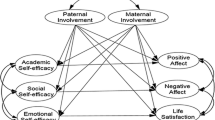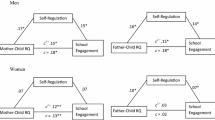Abstract
Research has shown that parents’ perceived parental self-efficacy (PSE) plays a pivotal role in promoting their children’s successful adjustment. In this study, we further explored this issue by comparing psychosocial adaptation in children of parents with high and low PSE during adolescence. One hundred and thirty Italian teenagers (55 males and 75 females) and one of their parents (101 mothers and 29 fathers) participated in the research. Data were collected at T1 (adolescents’ mean age = 13.6) and T2 (mean age = 17.5). Parents reported their PSE at T1. At T1 and T2, adolescents reported their perceived academic self-efficacy, aggressive and violent conducts, well-being, and perceived quality of their relationships with parents. At T2, they were also administered questions by using Experience Sampling Method to assess their quality of experience in daily life. As hypothesized, adolescents with high PSE parents reported higher competence, freedom and well-being in learning activities as well as in family and peer interactions. They also reported fewer problematic aspects and more daily opportunities for optimal experience. Findings pointed to the stability of adolescents’ psychosocial adaptation and highlighted possible directions in future research.
Similar content being viewed by others
References
Ardelt, M., & Eccles, J. S. (2001). Effects of mothers’ parental efficacy beliefs and promotive parenting strategies on inner-city youth. Journal of Family Issues, 22, 944–972.
Bandura, A. (1990). Multidimensional scale of perceived parental efficacy. Stanford: Stanford University.
Bandura, A. (1997). Self-efficacy: The exercise of control. Freeman: New York.
Bandura, A., Barbaranelli, C., Caprara, G. V., & Pastorelli, C. (1996). Multifaceted impact of self-efficacy beliefs on academic functioning. Child Development, 67, 1206–1222.
Bandura, A., Caprara, G. V., Barbaranelli, C., Pastorelli, C., & Regalia, C. (2001). Sociocognitive self-regulatory mechanisms governing trasgressive behavior. Journal of Personality and Social Psychology, 80, 125–135.
Barnes, H., & Olson, D. H. (1982). Parent-adolescent communication. In D. H. Olson, H. I. McCubbin, H. Barnes, A. Larsen, M. Muxen, & M. Wilson (Eds.), Family inventories (pp. 55–70). Minnesota: University of Minnesota.
Bassi, M., & Delle Fave, A. (2006). The daily experience of Italian adolescents’ in family interactions. Gender and developmental issues. In A. Delle Fave (Ed.), Dimensions of well-being. Research and Intervention (pp. 172–190). Milano: F. Angeli.
Bassi, M., Steca, P., Delle Fave, A., & Caprara, G. V. (2007). Academic self-efficacy beliefs and quality of experience in learning. Journal of Youth and Adolescence, 36, 301–312.
Bogenschneider, K., Small, S. A., & Tsay, J. C. (1997). Child, parent, and contextual influences on perceived parenting competence among parents of adolescents. Journal of Marriage & the Family, 59, 345–362.
Brown, B. B., Mounts, N., Lamborn, S. D., & Steinberg, L. (1993). Parenting practices and peer group affiliation. Child Development, 64, 467–482.
Capaldi, D., & Patterson, G. (1989). Psychometric properties of fourteen latent constructs from the Oregon Youth Study. New York: Springer.
Caprara, G. V., Mazzotti, E., & Prezza, M. (1988). La percezione della violenza [The perception of violence]. In L. A. B. OS (Ed.), Giovani e Violenza (pp. 37–49). Roma: TER.
Caprara, G. V., & Pastorelli, C. (1993). Early emotional instability, prosocial behavior and aggression: some methodological aspects. European Journal of Personality, 7, 19–36.
Caprara, G. V., Scabini, E., & Sgritta, G. (2003). The long transition to adulthood. In F. Pajares & T. Urdan (Eds.), International perspective on adolescence (pp. 71–99). Greenwich, CT: Information Age Publishing.
CIRMPA [Interuniversitary Centre for the Research on the Genesis and Development of Prosocial and Antisocial Motivation] (2006). Investigating deviant conduct from childhood to adolescence. Internal Report, University of Rome “La Sapienza”.
Cote, S. M., Boivin, M., Liu, X., Nagin, D. S., Zoccolillo, M., & Tremblay, R. E. (2009). Depression and anxiety symptoms: Onset, developmental course and risk factors during. Journal of Child Psychology and Psychiatry, 50, 1201–1208.
Csikszentmihalyi, M. (1997). Activity, experience and personal growth. In J. Curtis & S. Russell (Eds.), Physical activity in human experience: Interdisciplinary perspectives (pp. 59–88). Champaign, IL: Human Kinetics.
Csikszentmihalyi, M., & Csikszentmihalyi, I. (Eds.). (1988). Optimal experience—Psychological studies of flow in consciousness. Cambridge: Cambridge University Press.
Csikszentmihalyi, M., Larson, R., & Prescott, S. (1977). The ecology of adolescent activity and experience. Journal of Youth and Adolescence, 6, 281–294.
Csikszentmihalyi, M., & Massimini, F. (1985). On the psychological selection of bio-cultural information. New Ideas in Psychology, 3, 115–138.
Culbertson, F. M. (1997). Depression and gender. American Psychologist, 52, 25–31.
Delle Fave, A., & Bassi, M. (2000). The quality of experience in adolescents’ daily life: Developmental perspectives. Genetic, Social, and General Psychology Monographs, 126, 347–367.
Delle Fave, A., & Bassi, M. (2003). Italian adolescents and leisure: The role of engagement and optimal experience. In S. Verma & R. Larson (Eds.), Examining adolescent leisure time across cultures: Developmental opportunities and risks. New directions in child and adolescent development (pp. 79–93). San Francisco: Jossey-Bass.
Delle Fave, A., & Bassi, M. (2009). Sharing optimal experiences and promoting good community life in a multicultural society. Journal of Positive Psychology, 4, 280–289.
Delle Fave, A., & Massimini, F. (2004). Bringing subjectivity into focus: optimal experiences, life themes and person-centred rehabilitation. In P. A. Linley & S. Joseph (Eds.), Positive psychology in practice (pp. 581–597). London: Wiley.
Delle Fave, A., & Massimini, F. (2005). The investigation of optimal experience and apathy: Developmental and psychosocial implications. European Psychologist, 10, 264–274.
Diener, E., Emmons, R. A., Larsen, R. J., & Griffin, S. (1985). The satisfaction with life scale. Journal of Personality Assessment, 49, 71–75.
Gondoli, D. M., & Silverberg, S. B. (1997). Maternal emotional distress and diminished responsiveness: The mediating role of parenting efficacy and parental perspective taking. Developmental Psychology, 33, 861–868.
Hektner, J. (2001). Family, school, and community predictors of adolescent growth-conducive experiences: Global and specific approaches. Applied Developmental Science, 5, 172–183.
Hektner, J., Schmidt, J., & Csikszentmihalyi, M. (2007). Experience sampling method: Measuring the quality of everyday life. Thousand Oaks: Sage.
Hill, N. E., & Bush, K. R. (2001). Relationships between parenting environment and children’s mental health among African American and European American mothers and children. Journal of Marriage and the Family, 63, 954–966.
Hoover-Dempsey, K., Battiato, A. C., Walker, J. M. T., Reed, R. P., DeJong, J. M., & Jones, K. P. (2001). Parental involvement in homework. Educational Psychologist, 36, 195–209.
Izzo, C., Weiss, L., Shanahan, T., & Rodriguez-Brown, F. (2000). Parental self-efficacy and social support as predictors of parenting practices and children’s socio-emotional adjustment in Mexican immigrant families. Journal of Prevention & Intervention in the Community, 20, 197–213.
Jones, T. L., & Prinz, R. J. (2005). Potential roles of parental self-efficacy in parent and child adjustment: A review. Clinical Psychology Review, 25, 341–363.
King, V., & Elder, G. H. (1998). Perceived self-efficacy and grand parenting. Journal of Gerontology, 53B, S249–S257.
Kling, K. C., Hide, J. S., Showers, C. J., & Buswell, B. N. (1999). Gender differences in self-esteem: A meta-analysis. Psychological Bulletin, 12, 470–500.
Kovacs, M. (1985). The children’s depression inventory (CDI). Psychopharmacology Bulletin, 21, 995–1124.
Larson, R., & Delespaul, P. A. E. G. (1992). Analysing experience sampling data: A guidebook for the perplexed. In M. deVries (Ed.), The experience of psychopathology—Investigating mental disorders in their natural settings (pp. 58–78). Cambridge: Cambridge University Press.
Larson, R. W., & Richards, M. H. (1994). Divergent realities: The emotional lives of mothers, fathers, and adolescents. New York: Basic Books.
Larson, R. W., Richards, M. H., Moneta, G. B., Holmbeck, G., & Ducket, E. (1996). Changes in adolescents’ daily interactions with their families from ages 10 to 18: Disengagement and transformation. Developmental Psychology, 32, 744–754.
Lynch, J. (2002). Parents’ self-efficacy beliefs, parents’ gender, children’s reader self-perceptions, reading achievement and gender. Journal of Research in Reading, 25, 54–67.
Massimini, F., Csikszentmihalyi, M., & Carli, M. (1987). The monitoring of optimal experience. A tool for psychiatric rehabilitation. Journal of Nervous and Mental Disease, 175, 545–549.
Massimini, F., & Delle Fave, A. (2000). Individual development in a bio-cultural perspective. American Psychologist, 55, 24–33.
Murry, V. M., & Brody, G. H. (1999). Self-regulation and self-worth of black children reared in economically stressed, rural, single mother-headed families. Journal of Family Issues, 4, 458–484.
Pajares, F., & Schunk, D. H. (2001). Self-beliefs and school success: Self-efficacy, self-concept, and school achievement. In R. Riding & S. Rayner (Eds.), Perception (pp. 239–266). London: Ablex Publishing.
Radloff, L. S. (1977). The CES-D scale: A self-report depression scale for research in the general population. Applied Psychological Measurement, 1, 385–401.
Rathunde, K. (1997). Parent-adolescent interaction and optimal experience. Journal of Youth and Adolescence, 26, 669–689.
Rathunde, K. (2001). Family context and the development of undivided interest: A longitudinal study of family support and challenge and adolescents’ quality of experience. Applied Developmental Science, 5, 158–171.
Rosenberg, M. (1965). Society and the adolescent self-image. Princeton, NJ: Princeton University Press.
Scabini, E., & Cigoli, V. (1992). PASS: Parent-adolescent support scale. Unpublished manuscript.
Seligman, M. E. P., & Csikszentmihalyi, M. (2000). Positive psychology. American Psychologist, 55, 5–14.
Shumow, L., & Lomax, R. (2002). Parental self-efficacy: Predictor of parenting behavior adolescent outcomes. Parenting, Science and Practice, 2, 127–150.
Simmons, R., & Blyth, D. A. (1987). Moving into adolescence: The impact of pubertal change and school context. New York: Aldine de Gruyter.
Sroufe, L. A., & Fleeson, J. (1986). Attachment and the construction of relationships. In W. W. Hartup & Z. Rubin (Eds.), Relationships and development (pp. 51–77). Hillsdale, NJ: Lawrence Erlbaum Associates Inc.
Watson, D., Clark, L. A., & Tellegen, A. (1988). Development and validation of brief measures of positive and negative affect: The PANAS Scales. Journal of Personality and Social Psychology, 54, 1063–1070.
Xiang, P., McBride, R., & Bruene, A. (2003). Relations of parents’ beliefs to children’s motivation in an elementary physical education running program. Journal of Teaching in Physical Education, 22, 410–425.
Author information
Authors and Affiliations
Corresponding author
Appendix
Rights and permissions
About this article
Cite this article
Steca, P., Bassi, M., Caprara, G.V. et al. Parents’ Self-efficacy Beliefs and Their Children’s Psychosocial Adaptation During Adolescence. J Youth Adolescence 40, 320–331 (2011). https://doi.org/10.1007/s10964-010-9514-9
Received:
Accepted:
Published:
Issue Date:
DOI: https://doi.org/10.1007/s10964-010-9514-9




